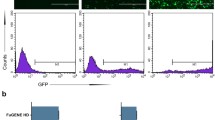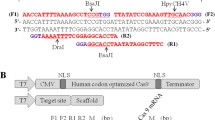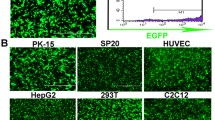Abstract
The domestic pig has been widely used as an important large animal model. Precise and efficient genetic modification in pig provides a great promise in biomedical research. Recently, clustered regularly interspaced short palindromic repeat (CRISPR)/CRISPR-associated (Cas) system has been successfully used to produce many gene-targeted animals. However, these animals have been generated by co-injection of Cas9 mRNA and single-guide RNA (sgRNA) into one-cell stage embryos, which mostly resulted in mosaicism of the modification. One or two rounds of further breeding should be performed to obtain homozygotes with identical genotype and phenotype. To address this issue, gene-targeted somatic cells can be used as donor for somatic cell nuclear transfer (SCNT) to produce gene-targeted animals with single and identical mutations. In this study, we applied Cas9/sgRNAs to effectively direct gene editing in porcine fetal fibroblasts and then mutant cell colonies were used as donor to generate homozygous gene-targeted pigs through single round of SCNT. As a result, we successfully obtained 15 tyrosinase (TYR) biallelic mutant pigs and 20 PARK2 and PINK1 double-gene knockout (KO) pigs. They were all homozygous and no off-target mutagenesis was detected by comprehensive analysis. TYR −/− pigs showed typical albinism and the expression of parkin and PINK1 were depleted in PARK2 −/−/PINK1 −/− pigs. The results demonstrated that single- or double-gene targeted pigs can be effectively achieved by using the CRISPR/Cas9 system combined with SCNT without mosaic mutation and detectable off-target effects. This gene-editing system provides an efficient, rapid, and less costly manner to generate genetically modified pigs or other large animals.



Similar content being viewed by others
Abbreviations
- Cas:
-
CRISPR-associated nuclease
- CRISPR:
-
Clustered regularly interspaced short palindromic repeats
- KO:
-
Knockout
- OTS:
-
Off-target site
- PFF:
-
Porcine fetal fibroblast
- PINK1:
-
PTEN-induced putative kinase 1
- SCNT:
-
Somatic cell nuclear transfer
- sgRNA:
-
Single-guide RNA
- TYR:
-
Tyrosinase
- WT:
-
Wild type
References
Li D, Qiu Z, Shao Y, Chen Y, Guan Y, Liu M, Li Y, Gao N, Wang L, Lu X, Zhao Y, Liu M (2013) Heritable gene targeting in the mouse and rat using a CRISPR-Cas system. Nat Biotechnol 31(8):681–683
Li W, Teng F, Li T, Zhou Q (2013) Simultaneous generation and germline transmission of multiple gene mutations in rat using CRISPR-Cas systems. Nat Biotechnol 31(8):684–686
Shen B, Zhang J, Wu H, Wang J, Ma K, Li Z, Zhang X, Zhang P, Huang X (2013) Generation of gene-modified mice via Cas9/RNA-mediated gene targeting. Cell Res 23(5):720–723
Ma Y, Zhang X, Shen B, Lu Y, Chen W, Ma J, Bai L, Huang X, Zhang L (2014) Generating rats with conditional alleles using CRISPR/Cas9. Cell Res 24(1):122–125
Wang H, Yang H, Shivalila CS, Dawlaty MM, Cheng AW, Zhang F, Jaenisch R (2013) One-step generation of mice carrying mutations in multiple genes by CRISPR/Cas-mediated genome engineering. Cell 153(4):910–918
Hai T, Teng F, Guo R, Li W, Zhou Q (2014) One-step generation of knockout pigs by zygote injection of CRISPR/Cas system. Cell Res 24(3):372–375
Niu Y, Shen B, Cui Y, Chen Y, Wang J, Wang L, Kang Y, Zhao X, Si W, Li W, Xiang AP, Zhou J, Guo X, Bi Y, Si C, Hu B, Dong G, Wang H, Zhou Z, Li T, Tan T, Pu X, Wang F, Ji S, Zhou Q, Huang X, Ji W, Sha J (2014) Generation of gene-modified cynomolgus monkey via Cas9/RNA-mediated gene targeting in one-cell embryos. Cell 156(4):836–843
Hsu PD, Lander ES, Zhang F (2014) Development and application of CRISPR-Cas9 for genome engineering. Cell 157(6):1262–1278
Tan W, Carlson DF, Lancto CA, Garbe JR, Webster DA, Hackett PB, Fahrenkrug SC (2013) Efficient nonmeiotic allele introgression in livestock using custom endonucleases. Proc Natl Acad Sci USA 110(41):16526–16531
Oetting WS, King RA (1999) Molecular basis of albinism: mutations and polymorphisms of pigmentation genes associated with albinism. Hum Mutat 13(2):99–115
William SO (2000) The tyrosinase gene and Oculocutaneous Albinism Type 1 (OCA1): a Model for understanding the molecular biology of melanin formation. Pigment Cell Res 13(5):320–325
Ota S, Hisano Y, Ikawa Y, Kawahara A (2014) Multiple genome modifications by the CRISPR/Cas9 system in zebrafish. Genes Cells 19(7):555–564
Kitada T, Asakawa S, Hattori N, Matsumine H, Yamamura Y, Minoshima S, Yokochi M, Mizuno Y, Shimizu N (1998) Mutations in the parkin gene cause autosomal recessive juvenile parkinsonism. Nature 392(6676):605–608
Valente EM, Abou-Sleiman PM, Caputo V, Muqit MM, Harvey K, Gispert S, Ali Z, Del Turco D, Bentivoglio AR, Healy DG, Albanese A, Nussbaum R, González-Maldonado R, Deller T, Salvi S, Cortelli P, Gilks WP, Latchman DS, Harvey RJ, Dallapiccola B, Auburger G, Wood NW (2004) Hereditary early-onset Parkinson’s disease caused by mutations in PINK1. Science 304(5674):1158–1160
Cong L, Ran FA, Cox D, Lin S, Barretto R, Habib N, Hsu PD, Wu X, Jiang W, Marraffini LA, Zhang F (2013) Multiplex genome engineering using CRISPR/Cas systems. Science 339(6121):819–823
Mali P, Yang L, Esvelt KM, Aach J, Guell M, DiCarlo JE, Norville JE, Church GM (2013) RNA-guided human genome engineering via Cas9. Science 339(6121):823–826
Lai L, Kolber-Simonds D, Park KW, Cheong HT, Greenstein JL, Im GS, Samuel M, Bonk A, Rieke A, Day BN, Murphy CN, Carter DB, Hawley RJ, Prather RS (2002) Production of alpha-1,3-galactosyltransferase knockout pigs by nuclear transfer cloning. Science 295(5557):1089–1092
Yang D, Yang H, Li W, Zhao B, Ouyang Z, Liu Z, Zhao Y, Fan N, Song J, Tian J, Li F, Zhang J, Chang L, Pei D, Chen YE, Lai L (2011) Generation of PPAR gamma mono-allelic knockout pigs via zinc-finger nucleases and nuclear transfer cloning. Cell Res 21(6):979–982
Xin J, Yang H, Fan N, Zhao B, Ouyang Z, Liu Z, Zhao Y, Li X, Song J, Yang Y, Zou Q, Yan Q, Zeng Y, Lai L (2013) Highly efficient generation of GGTA1 biallelic knockout inbred mini-pigs with TALENs. PLoS ONE 8(12):e84250
Ran FA, Hsu PD, Lin CY, Gootenberg JS, Konermann S, Trevino AE, Scott DA, Inoue A, Matoba S, Zhang Y, Zhang F (2013) Double nicking by RNA-guided CRISPR Cas9 for enhanced genome editing specificity. Cell 154(6):1380–1389
Fu Y, Foden JA, Khayter C, Maeder ML, Reyon D, Joung JK, Sander JD (2013) High-frequency off-target mutagenesis induced by CRISPR-Cas nucleases in human cells. Nat Biotechnol 31(9):822–826
Hsu PD, Scott DA, Weinstein JA, Ran FA, Konermann S, Agarwala V, Li Y, Fine EJ, Wu X, Shalem O, Cradick TJ, Marraffini LA, Bao G, Zhang F (2013) DNA targeting specificity of RNA-guided Cas9 nucleases. Nat Biotechnol 31(9):827–832
Pattanayak V, Lin S, Guilinger JP, Ma E, Doudna JA, Liu DR (2013) High-throughput profiling of off-target DNA cleavage reveals RNA-programmed Cas9 nuclease specificity. Nat Biotechnol 31(9):839–843
Fu Y, Sander JD, Reyon D, Cascio VM, Joung JK (2014) Improving CRISPR-Cas nuclease specificity using truncated guide RNAs. Nat Biotechnol 32(3):279–284
Gaj T, Guo J, Kato Y, Sirk SJ, Barbas CF 3rd (2012) Targeted gene knockout by direct delivery of zinc-finger nuclease proteins. Nat Methods 9(8):805–807
Acknowledgments
This study was supported by the Natural Science Foundation of China (Nos. 31301103 and 31360532) to H.Y. and J.X., the National Basic Research Program of China (973 program; No. 2011CB944203) to L. L.
Conflict of interest
The authors have declared no conflict of interest.
Author information
Authors and Affiliations
Corresponding author
Additional information
X. Zhou and J. Xin contributed equally to this manuscript.
Electronic supplementary material
Below is the link to the electronic supplementary material.
Rights and permissions
About this article
Cite this article
Zhou, X., Xin, J., Fan, N. et al. Generation of CRISPR/Cas9-mediated gene-targeted pigs via somatic cell nuclear transfer. Cell. Mol. Life Sci. 72, 1175–1184 (2015). https://doi.org/10.1007/s00018-014-1744-7
Received:
Revised:
Accepted:
Published:
Issue Date:
DOI: https://doi.org/10.1007/s00018-014-1744-7




